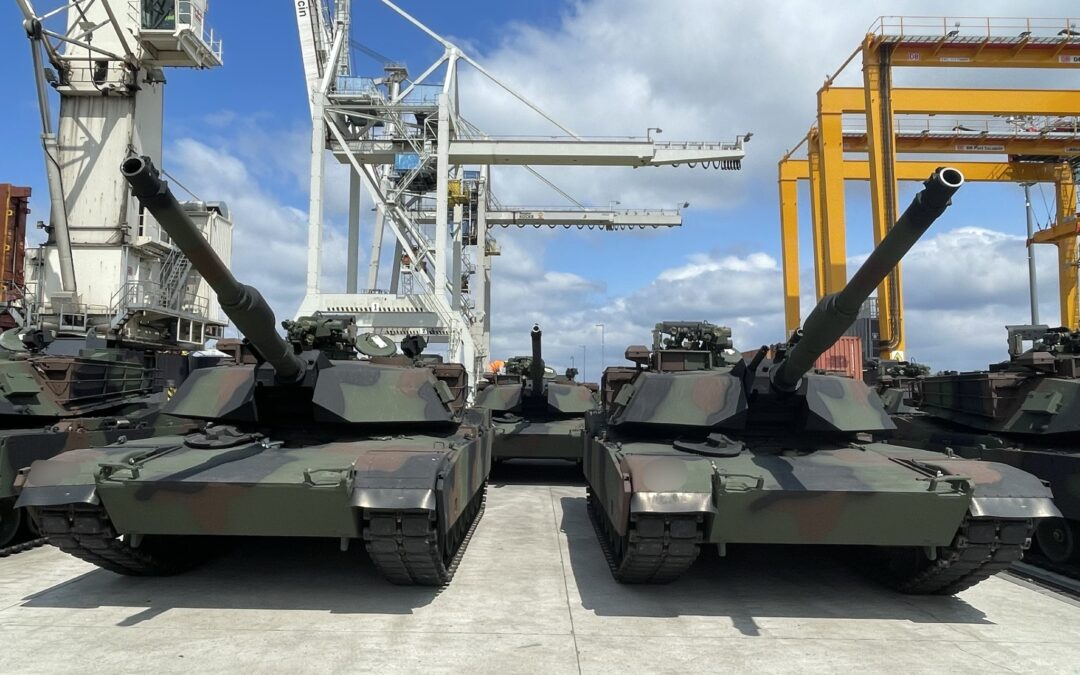Poland has received the first of hundreds of Abrams tanks that it has ordered from the United States, becoming the first European or NATO country – other than the US itself – to operate the vehicles. This week it was also announced that Poland will host a new service centre for Abrams tanks.
“This is a historic day for the Polish army,” said defence minister Mariusz Błaszczk, unveiling the newly arrived 14 Abrams.
“[Given] what is happening in Ukraine, we are focused on strengthening the Polish army. That is what we have achieved with our American partners…These tanks will strengthen our deterrent power.”
Minister @mblaszczak: dziś na polskiej ziemi są już pierwsze egzemplarze czołgów #Abrams. To historyczny dzień dla Wojska Polskiego. pic.twitter.com/jt6snmyE5s
— Ministerstwo Obrony Narodowej 🇵🇱 (@MON_GOV_PL) June 28, 2023
In July 2021, Poland announced the purchase of 250 of the latest M1A2 Abrams tanks for $4.7 billion in a deal that the government made clear was intended to be a deterrent against Russian aggression.
One year later – following Russia’s invasion of neighbouring Ukraine – Poland agreed to the additional purchase of 116 used Abrams tanks and accompanying equipment in a contract worth $1.4 billion. That came after Warsaw had donated over 240 of its own Soviet-designed T-72 tanks to Kyiv.
Yesterday, the first Abrams tanks from the latter deal arrived by ship at the port of Świnoujście on Poland’s northern Baltic coast, having departed from Charleston, South Carolina, reports Polsat News.
The 14 vehicles, previously used by the US Marine Corps, are enough to form one company. Poland is expecting the delivery of 28 further such tanks by the end of this year, which will mean enough to form a battalion, Błaszczak told broadcaster TVP yesterday. Another 42 will be delivered in 2024.
Poland has approved a $1.4 billion deal to buy 116 Abrams tanks from the US.
Around 14% of the costs will be covered by the US itself as part of military aid to Poland https://t.co/WBo5Y44XFk
— Notes from Poland 🇵🇱 (@notesfrompoland) January 4, 2023
Last August, a so-called “Abrams Academy” was opened in Poland in cooperation with the US, and it has already been training Polish personnel in using the vehicles.
On Monday this week, it was also announced that a centre for maintaining and servicing Abrams tanks will be established in Poznań, the city that is home to the US Army’s first permanent base on NATO’s eastern flank.
The centre will be used not only by Poland, but also by the US itself and other future European operators of the Abrams, such as Romania, reports military news service Defence24.
– Dziś rozpoczynamy nową kartę w historii #WZM i #PGZ. Naszym zadaniem jest zapewnienie serwisu każdego sprzętu, jaki trafia do 🇵🇱armii. Teraz są to czołgi #Abrams, dlatego musimy utworzyć Centrum Kompetencyjne tych czołgów. To centrum powstanie w WZM -mówi prezes S. Chwałek pic.twitter.com/hZZbucdNbO
— Polska Grupa Zbrojeniowa🇵🇱 (@PGZ_pl) June 26, 2023
Russia’s invasion of Ukraine has prompted Poland’s government – which was already expanding and modernising the armed forces – to further accelerate military spending, which was raised to 3% of GDP last year and 4% this year – the highest relative level in NATO.
As well as extensive purchases from the US – including Patriot air defence systems, HIMARS rocket launchers and F-35 combat aircraft – Poland has also signed deals to buy hundreds of tanks, howitzers and fighter jets from South Korea, the first of which were delivered in December last year.
This morning, Błaszczak repeated a previous pledge that “within two years, Poland will have the strongest land army in Europe”.
Poland's army "will become the most powerful land force in Europe", says the defence minister, after confirming a deal with South Korea that will see Poland acquire almost 1,000 tanks.
The government recently increased defence spending to 3% of GDP https://t.co/EVanuDXz5W
— Notes from Poland 🇵🇱 (@notesfrompoland) July 29, 2022
Main image credit: MON_GOV_PL/Twitter

Daniel Tilles is editor-in-chief of Notes from Poland. He has written on Polish affairs for a wide range of publications, including Foreign Policy, POLITICO Europe, EUobserver and Dziennik Gazeta Prawna.




















